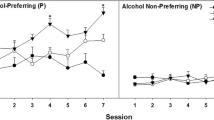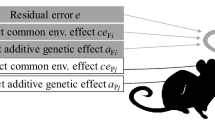Abstract
With the goal of producing an animal model of alcohol dependence, genetic selection in mice for severity of the alcohol withdrawal syndrome is underway. Ten generations of selection have been completed, and the lines selected for severe or mild expression of the withdrawal syndrome following a 9-day ethanol treatment period are significantly different from each other. The index of selection is the unrotated first-principal-component score derived from the intercorrelations among seven different measures of severity of ethanol withdrawal. Across the generations, mice from all six closed mating populations have increased their mean consumption of alcohol considerably. This seems to be the result of natural selection operating concurrently with artificial selection. When animals from generation 9 were used to test for possible correlated responses to selection, there was an indication that animals selected for mild expression of withdrawal symptoms are also less sensitive to an acute dose of ethanol.
Similar content being viewed by others
References
Allen, D. L., Petersen, D. R., Wilson, J. R., McClearn, G. E., and Nishimoto, T. K. (1983). Selective breeding for a multivariate index of ethanol dependence in mice: Results from the first five generations.Alcoholism: Clin. Exp. Res. 7:443–447.
Belknap, J. K. (1980). Genetic factors in the effects of alcohol: Neurosensitivity, functional tolerance, and physical dependence. In Rigter, H., and Crabbe, J. C. (eds.),Alcohol Tolerance and Dependence. Elsevier/North-Holland, Amsterdam, pp. 157–180.
Cicero, T. J. (1980). Animal models of alcoholism? In Eriksson, K., Sinclair, J. D., and Kiianmaa (eds.),Animal Models in Alcohol Research, Academic Press, London, pp. 99–117.
Crabbe, J. C. (1983). Sensitivity to ethanol in inbred mice: Genotypic correlations among several behavioral measures.Behav. Neurosci. 97:280–289.
Crabbe, J. C., Kosobud, A., and Young, E. R. (1983a). Genetic selection for ethanol withdrawal severity: Differences in replicate mouse lines.Life Sci. 33:955–962.
Crabbe, J. C., Kosobud, A., Young, E. R., and Janowsky, J. S. (1983b). Polygenic and single-gene determination of responses to ethanol in BXD/Ty recombinant inbred mouse strains.Neurobehav. Toxicol. Teratol. 5:181–187.
Crabbe, J. C., Young, E. R., and Kosobud, A. (1983c). Genetic correlations with ethanol withdrawal severity.Pharmacol. Biochem. Behav. 18:541–547.
DeFries, J. C. (1981). Selective breeding for behavioral and pharmacological responses in laboratory mice. In Gershon, E. S., Matthysse, S., Breakefield, X. O., and Ciaranello, R. D. (eds.),Genetic Research Strategies for Psychobiology and Psychiatry, Boxwood Press, Pacific Grove, Calif. pp. 199–214.
DeFries, J. C., Wilson, J. R., and McClearn, G. E. (1970). Open-field behavior in mice: Selection response and situational generality.Behav. Genet. 1:195–211.
DeFries, J. C., Hyde, J. S., Lynch, C., Petersen, D. R., and Roberts, R. C. (1981). The design of selection experiments. In McClearn, G. E., Deitrich, R. A., and Erwin, V. G. (eds.),Development of Animal Models as Pharmacogenetic Tools, DHHS Publication No. (ADM) 81-1133, U.S. Government Printing Office, Washington, D.C., pp. 269–275.
Eriksson, K., Sinclair, J. D., and Kiianmaa, K. (1980).Animal Models in Alcohol Research, Academic Press, London.
Falconer, D. S. (1960).Quantitative Genetics, Ronald Press, New York.
Freund, G. (1980). Comparison of alcohol dependence, withdrawal and hangover in humans and animals. In Eriksson, K., Sinclair, J. D., and Kiianmaa, K. (eds.),Animals Models in Alcohol Research, Academic Press, London, pp. 293–308.
Goldstein, D. B. (1972). The relationship of alcohol dose to intensity of withdrawal signs in mice.J. Pharmacol. Exp. Ther. 180:203–215.
Goldstein, D. B. (1973). Inherited differences in intensity of alcohol withdrawal symptoms in mice.Nature 245:154–156.
Goldstein, D. B., and Pal, N. (1971). Alcohol dependence produced in mice by inhalation of ethanol: Grading the withdrawal reaction.Science 172:288–290.
Goodwin, D. W. (1980). The genetics of alcoholism.Substance Alc. Act./Misuse 1:101–117.
Goodwin, D. W., Schulsinger, F., Hermansen, L., Guze, S. B., and Winokur, G. (1973). Alcohol problems in adoptees raised apart from alcoholic biological parents.Arch. Gen. Psychiat. 28:238–243.
McClearn, G. E., Deitrich, R. A., and Erwin, V. G. (eds.) (1981).Development of Animal Models as Pharmacogenetic Tools, DHHS Publication No. (ADM) 81-1133, U.S. Goverment Printing Office, Washington, D.C.
McClearn, G. E., Wilson, J. R., and Meredith, W. (1970). The use of isogenic and heterogenic mouse stocks in behavioral research. In Lindzey, G., and Thiessen, D. D. (eds.),Contributions to Behavior-Genetic Analysis: The Mouse as a Prototype, Appleton-Century-Crofts, New York, pp. 3–22.
McClearn, G. E., Wilson, J. R., and Petersen, D. R. (1982). Selective breeding in mice for severity of the ethanol withdrawal syndrome.Substance Alc. Act./Misuse 3:135–143.
Roberts, R. C. (1981). Current perspectives on selective breeding: Theoretical aspects. In McClearn, G. E., Deitrich, R. A., and Erwin, V. G., (eds.),Development of Animal Models as Pharmacogenetic Tools, DHHS Publication No. (ADM) 81-1133, U.S. Government Printing Office, Washington, D.C., pp. 37–58.
Schuckit, M. A., and Rayses, V. (1979). Ethanol ingestion: Differences in blood acetaldehyde concentrations in relatives of alcoholics and controls.Science 203:54–55.
Tabakoff, B., and Ritzman, R. F. (1979). Acute tolerance in inbred and selected lines of mice.Drug Alc. Depend. 12:87–90.
Author information
Authors and Affiliations
Additional information
This work was supported by NIAAA Grant AA-03527.
Rights and permissions
About this article
Cite this article
Wilson, J.R., Erwin, V.G., DeFries, J.C. et al. Ethanol dependence in mice: Direct and correlated responses to ten generations of selective breeding. Behav Genet 14, 235–256 (1984). https://doi.org/10.1007/BF01065544
Received:
Accepted:
Issue Date:
DOI: https://doi.org/10.1007/BF01065544




